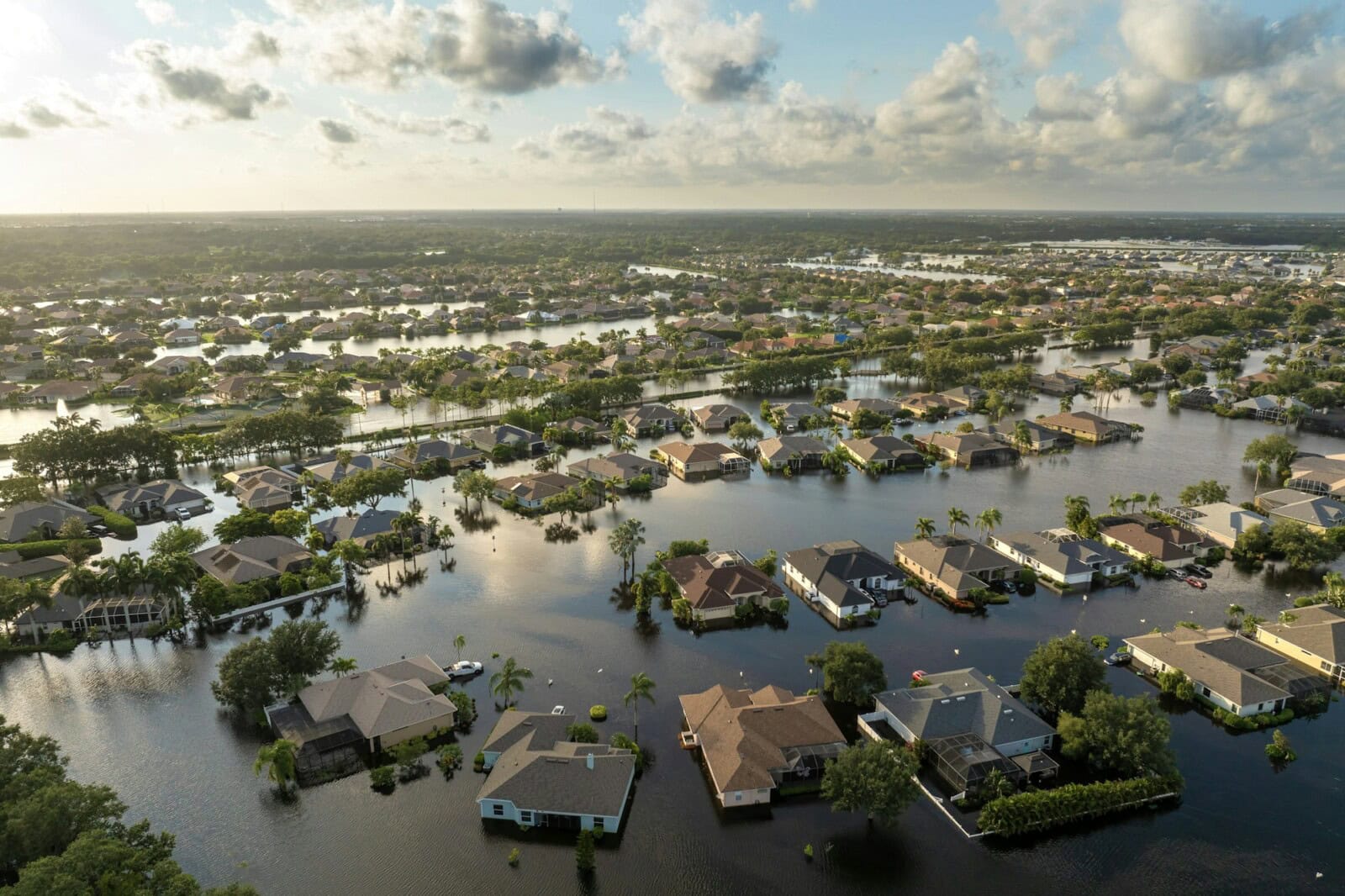Florida homeowners are facing an ever-increasing risk of flooding due to development throughout the state, climate change, and other factors, making flood prevention a critical concern. Rising sea levels, more frequent hurricanes, and intense rainfall events pose significant threats to residential properties, particularly their foundations.
Keep reading to learn about practical methods and strategies for safeguarding your home against Florida's flood risks.

Understanding Florida's Flood Risks
Florida's unique geographical and climatic conditions make it particularly vulnerable to flooding. The state's low-lying topography, extensive coastline, and numerous inland water bodies contribute to its susceptibility. Hurricanes and tropical storms, which frequently impact Florida, can bring storm surges and heavy rainfall, leading to widespread flooding in coastal and inland areas.
Climate change has exacerbated these risks, with rising sea levels threatening coastal communities and increasing the frequency and intensity of extreme weather events. According to the National Oceanic and Atmospheric Administration (NOAA), Florida has experienced a sea level rise of about 8 inches since 1950, with projections indicating a further rise of up to 17 inches by 2040.
These conditions can severely impact home foundations, causing structural damage, water intrusion, and long-term stability issues.
Assessing Your Home's Current Foundation
Before implementing flood prevention tactics, it's important to assess the current state of your home's foundation. This evaluation helps identify any existing vulnerabilities and potential weak points that may require immediate attention. Homeowners should look for signs of foundation damage, such as:
- Cracks in walls or floors
- Uneven floors
- Doors and windows that stick or don't close properly
- Gaps between walls and ceilings or floors
- Visible water stains or mold growth in the basement or crawl space
While a visual inspection can provide valuable insights, it's often beneficial to enlist the services of a professional foundation inspector. These experts can conduct a thorough assessment using specialized tools and techniques to detect hidden issues that may not be apparent to the untrained eye.
Elevating Your Home's Foundation
Elevating a home's foundation is one of the most effective ways to protect it from flood damage. This process involves raising the entire structure above the expected flood levels. In Florida, the average height increase for effective flood prevention typically ranges from 3 to 8 feet, depending on the specific location and flood risk assessment.
Pier and Beam Elevation
The pier and beam elevation method involves lifting and supporting the house on a series of concrete piers or steel beams. This approach creates an open space beneath the home, allowing floodwaters to flow underneath without damaging the living areas.
Pier and beam elevation offers several benefits, including improved flood protection, better ventilation, and easier access to utilities. However, it can be complex and costly, especially for larger homes or those with slab foundations.
Slab Elevation
Slab elevation is a method used for homes built on concrete slab foundations. This process involves lifting the entire slab along with the house structure. While more challenging than elevating a pier and beam foundation, it's often necessary for many Florida homes built on slabs.
The slab elevation process typically involves cutting the slab from the foundation walls, lifting it hydraulically, and then building a new elevated foundation underneath. This method can provide excellent flood protection but may require significant modifications to the home's exterior, including new stairs and porches to accommodate the increased height.
Costs and Permitting for Foundation Elevation
The costs associated with foundation elevation can vary significantly depending on factors such as the size and weight of the home, the current foundation type, and the desired elevation height. On average, homeowners can expect to pay between $30,000 and $100,000 for a foundation elevation project, with some larger or more complex projects exceeding this range.
To help manage these costs, homeowners may explore financing options such as home improvement loans or government assistance programs. The Federal Emergency Management Agency (FEMA) offers Flood Mitigation Assistance grants to eligible homeowners in high-risk flood areas, which can help cover the costs of elevation projects.
In Florida, the permitting process for foundation elevation is typically handled at the local level. Homeowners must obtain permits from their city or county building department before starting elevation work. The permitting process often involves submitting detailed plans, engineering calculations, and flood zone certifications.
Reinforcing Your Home's Foundation
While elevation is a powerful flood prevention tactic, reinforcing the existing foundation can also provide significant protection against flood damage. Various methods can be employed to strengthen a foundation's resistance to water intrusion and structural damage. These methods are generally less expensive than full elevation but may offer less comprehensive protection.
Waterproofing Techniques
Waterproofing is a crucial step in protecting a home's foundation from flood damage. Several effective techniques can be applied to both the exterior and interior of the foundation.
Exterior waterproofing typically involves applying a waterproof coating or membrane to the outside of the foundation walls. This can be done by excavating around the foundation, applying the waterproofing material, and then backfilling. These treatments generally last 10 to 20 years, depending on the product used and environmental conditions.
Interior waterproofing focuses on managing water that has already entered the foundation area. This can include applying sealants to walls and floors, installing a perimeter drainage system, or using specialized paints to resist water penetration. Interior waterproofing methods often require maintenance every 5 to 10 years to ensure continued effectiveness.
Installing Flood Vents
Flood vents are specially designed openings installed in foundation walls or garage doors to allow floodwaters to flow freely through enclosed areas. These vents help equalize hydrostatic pressure on both sides of the foundation walls, reducing the risk of structural damage during a flood.
Installing flood vents is particularly important for homes with enclosed areas below the Base Flood Elevation (BFE). Many flood-prone areas require flood vents as part of their building codes.
Additional Reinforcement Methods
Several other methods can be employed to further reinforce a home's foundation against flood damage. Installing French drains around the home's perimeter can help divert water from the foundation. This involves creating a trench filled with gravel and a perforated pipe that channels water to a safe discharge point.
Proper landscaping and grading can also play a crucial role in flood prevention. Ensuring the ground slopes away from the foundation helps direct water away from the home. In some cases, building berms or installing retaining walls may be necessary to manage water flow effectively.
Insurance Benefits of Flood Prevention Measures
Implementing flood prevention tactics can lead to significant insurance benefits for Florida homeowners. Many insurance companies offer reduced premiums for homes elevated or reinforced against flood damage. These discounts acknowledge the reduced risk of claims and can result in substantial savings over time.
The National Flood Insurance Program (NFIP), which provides flood insurance to many Florida residents, offers particularly notable benefits for elevated homes. Properties raised above the BFE can qualify for significantly lower insurance rates. In some cases, homeowners have reported premium reductions of up to 60% after elevating their homes.
It's important to note that standard homeowners insurance policies typically do not cover flood damage. Florida homeowners, especially those in high-risk flood zones, should consider purchasing separate flood insurance.
Legal Considerations for Foundation Modifications
Florida homeowners should be aware of various legal considerations when undertaking foundation modifications for flood prevention. Local building codes and zoning regulations play a significant role in determining what modifications are allowed and how they must be implemented.
Homeowners associations (HOAs) may also have rules that impact foundation modification projects. Some HOAs have strict guidelines regarding changes to a home's exterior appearance, which could affect elevation projects or the installation of visible flood prevention measures.
Working with licensed and insured contractors is vital for ensuring quality work and legal protection. Unlicensed work can lead to liability issues and may even invalidate insurance coverage. Non-compliance with local regulations or HOA rules could result in fines, legal action, or the need to reverse modifications, potentially costing homeowners significant time and money.
Maintenance Requirements for Flood Prevention Tactics
Implementing flood prevention measures is not a one-time task; it requires ongoing maintenance to ensure long-term effectiveness. Regular inspections of elevated foundations, waterproofing systems, and flood vents are essential. Homeowners should conduct visual checks at least annually and after significant weather events.
Depending on the method used, waterproofing treatments may need to be reapplied every 5 to 20 years. Flood vents should be kept clear of debris to ensure proper function. Landscaping and drainage systems should be maintained regularly to prevent water from accumulating near the foundation.
Emerging Technologies in Flood Prevention
As flood risks continue to increase, new technologies are emerging to help protect homes. Some innovative solutions include:
- Smart flood sensors that can detect water intrusion and alert homeowners
- Advanced sump pump systems with battery backups and remote monitoring capabilities
- Nano-coatings that can be applied to foundation materials to enhance water resistance
- Inflatable flood barriers that can be quickly deployed around a home's perimeter
While these technologies are promising, they should be considered as supplements to, rather than replacements for, traditional flood prevention methods.
Speak To An Attorney About Flood Damage To Your Property
Implementing effective flood prevention tactics for your home's foundation is crucial in protecting your property from Florida's increasing flood risks. By understanding the various methods of elevation and reinforcement, homeowners can make informed decisions to safeguard their investments and ensure long-term safety.
While the costs associated with these measures can be significant, the potential benefits of reduced damage, lower insurance premiums, and increased property value often outweigh the initial investment. Given the rising flood risks in Florida, taking action sooner rather than later is essential to protect your home and financial security.
If you’ve recently experienced property damage due to flooding in Florida, the experienced property damage attorneys at Weinstein Legal Team may be able to help. We can guide you through the complexities of property insurance claims, negotiations, permitting processes, and any legal issues that may arise during your claim. Call us today at 888-626-1108 or click here to schedule a free consultation with an attorney near you.


